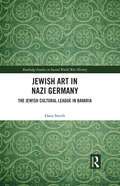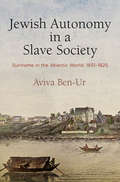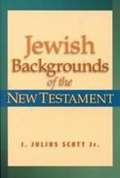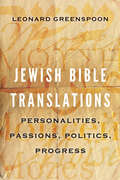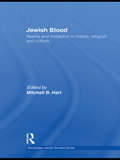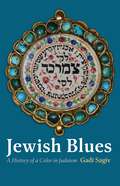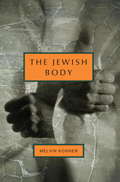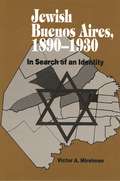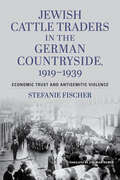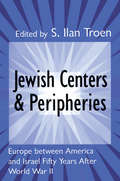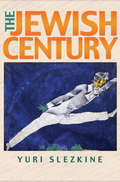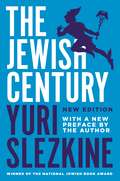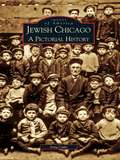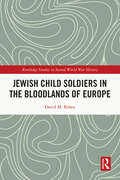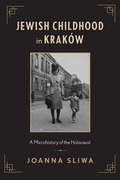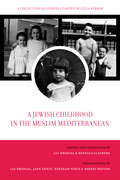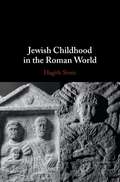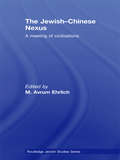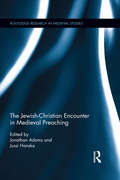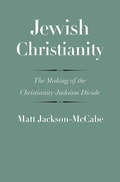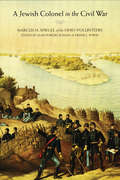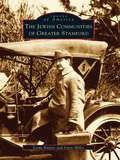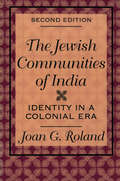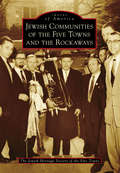- Table View
- List View
Jewish Art in Nazi Germany: The Jewish Cultural League in Bavaria (Routledge Studies in Second World War History)
by Dana SmithThis book provides a social and cultural history of Jewish art in Nazi Germany, with a focus on the Jewish artists, art critics, and audiences in Nazi Bavaria. From the time of its conceptualization in the autumn of 1933 until its final curtain call in November 1938, the Jewish Cultural League in Bavaria sustained three departments: music, visual arts, and adult education. The Bavarian example steps outside the highly professional cultural milieu of Jewish Berlin, and instead looks at relatively unknown efforts of Bavarian Jewish artists as they used art to define what it now meant, to them, to be Jewish under Nazism. Insightful and engaging, this book is ideal for advanced undergraduate students, graduate students, and scholars interested in social and cultural histories of Jews in Germany.
Jewish Autonomy in a Slave Society: Suriname in the Atlantic World, 1651-1825 (The Early Modern Americas)
by Aviva Ben-UrA fascinating portrait of Jewish life in Suriname from the 17th to 19th centuriesJewish Autonomy in a Slave Society explores the political and social history of the Jews of Suriname, a Dutch colony on the South American mainland just north of Brazil. Suriname was home to the most privileged Jewish community in the Americas where Jews, most of Iberian origin, enjoyed religious liberty, were judged by their own tribunal, could enter any trade, owned plantations and slaves, and even had a say in colonial governance.Aviva Ben-Ur sets the story of Suriname's Jews in the larger context of Atlantic slavery and colonialism and argues that, like other frontier settlements, they achieved and maintained their autonomy through continual negotiation with the colonial government. Drawing on sources in Dutch, English, French, Hebrew, Portuguese, and Spanish, Ben-Ur shows how, from their first permanent settlement in the 1660s to the abolition of their communal autonomy in 1825, Suriname Jews enjoyed virtually the same standing as the ruling white Protestants, with whom they interacted regularly. She also examines the nature of Jewish interactions with enslaved and free people of African descent in the colony. Jews admitted both groups into their community, and Ben-Ur illuminates the ways in which these converts and their descendants experienced Jewishness and autonomy. Lastly, she compares the Jewish settlement with other frontier communities in Suriname, most notably those of Indians and Maroons, to measure the success of their negotiations with the government for communal autonomy. The Jewish experience in Suriname was marked by unparalleled autonomy that nevertheless developed in one of the largest slave colonies in the New World.
Jewish Backgrounds of the New Testament
by J. Julius Scott Jr.This survey of intertestamental Judaism illuminates the customs and controversies that provide essential background for understanding the New Testament. Scott opens a door into the Jewish world and literature leading up to the development of Christianity. He also offers an accessible overview of the data through helpful charts, maps, and diagrams incorporated throughout the text to engage his readers.
Jewish Bible Translations: Personalities, Passions, Politics, Progress
by Leonard GreenspoonJewish Bible Translations is the first book to examine Jewish Bible translations from the third century BCE to our day. It is an overdue corrective of an important story that has been regularly omitted or downgraded in other histories of Bible translation. Examining a wide range of translations over twenty-four centuries, Leonard Greenspoon delves into the historical, cultural, linguistic, and religious contexts of versions in eleven languages: Arabic, Aramaic, English, French, German, Greek, Hungarian, Italian, Russian, Spanish, and Yiddish. He profiles many Jewish translators, among them Buber, Hirsch, Kaplan, Leeser, Luzzatto, Mendelssohn, Orlinsky, and Saadiah Gaon, framing their aspirations within the Jewish and larger milieus in which they worked. Greenspoon differentiates their principles, styles, and techniques—for example, their choice to emphasize either literal reflections of the Hebrew or distinctive elements of the vernacular language—and their underlying rationales. As he highlights distinctive features of Jewish Bible translations, he offers new insights regarding their shared characteristics and their limits. Additionally, Greenspoon shows how profoundly Jewish translators and interpreters influenced the style and diction of the King James Bible. Accessible and authoritative for all from beginners to scholars, Jewish Bible Translations enables readers to make their own informed evaluations of individual translations and to holistically assess Bible translation within Judaism.
Jewish Blood: Reality and metaphor in history, religion and culture (Routledge Jewish Studies Series)
by Mitchell B. HartThis book deals with the Jewish engagement with blood: animal and human, real and metaphorical. Concentrating on the meaning or significance of blood in Judaism, the book moves this highly controversial subject away from its traditional focus, exploring how Jews themselves engage with blood and its role in Jewish identity, ritual and culture. With contributions from leading scholars in the field, the book brings together a wide range of perspectives and covers communities in ancient Israel, Europe and America, as well as all major eras of Jewish history: biblical, Talmudic, medieval and modern. Providing historical, religious and cultural examples ranging from the "Blood Libel" through to the poetry of Uri Zvi Greenberg, this volume explores the deep continuities in thought and practice related to blood. Moreover, it examines the continuities and discontinuities between Jewish and Christian ideas and practices related to blood, many of which extend into the modern, contemporary period. The chapters look at not only the Jewish and Christian interaction, but the interaction between Jews and the individual national communities to which they belong, including the complex appropriation and rejection of European ideas and images undertaken by some Zionists, and then by the State of Israel. This broad-ranging and multidisciplinary work will be of interest to students of Jewish Studies, History and Religion.
Jewish Blues: A History of a Color in Judaism (Jewish Culture and Contexts)
by Gadi SagivJewish Blues presents a broad cultural, social, and intellectual history of the color blue in Jewish life between the sixteenth and twenty-first centuries. Bridging diverse domains such as religious law, mysticism, eschatology, as well as clothing and literature, this book contends that, by way of a protracted process, the color blue has constituted a means through which Jews have understood themselves.In ancient Jewish texts, the term for blue, tekhelet, denotes a dye that serves Jewish ritual purposes. Since medieval times, however, Jews gradually ceased to use tekhelet in their ritual life. In the nineteenth century, however, interest in restoring ancient dyes increased among European scholars. In the Jewish case, rabbis and scientists attempted to reproduce the ancient tekhelet dye. The resulting dyes were gradually accepted in the ritual life of many Orthodox Jews. In addition to being a dye playing a role in Jewish ritual, blue features prominently in the Jewish mystical tradition, in Jewish magic and popular custom, and in Jewish eschatology. Blue is also representative of the Zionist movement, and it is the only chromatic color in the national flag of the State of Israel.Through the study of the changing roles and meanings attributed to the color blue in Judaism, Jewish Blues sheds new light on the power of a visual symbol in shaping the imagination of Jews throughout history. The use of the color blue continues to reflect pressing issues for Jews in our present era, as it has become a symbol of Jewish modernity.
The Jewish Body: A History (Jewish Culture and Contexts)
by Robert JütteAn encyclopedic survey of the Jewish body as it has existed and as it has been imagined from biblical times to the presentThat the human body can be the object not only of biological study but also of historical consideration and cultural criticism is now widely accepted. But why, Robert Jütte asks, should a historian bother with the Jewish body in particular? And is the "Jewish body" as much a concept constructed over the course of centuries by Jews and non-Jews alike as it is a physical reality? To comprehend the notion and existence of a Jewish body, he contends, one needs to look both at the images and traits that have been ascribed to Jews by themselves and others, and to the specific bodily practices that have played an important role in creating the identity of a religious and cultural community.Jütte has written an encyclopedic survey of the Jewish body as it has existed and as it has been imagined from biblical times to the present, often for anti-Jewish purposes. He examines the techniques for caring for the body that Jews acquire in childhood from parents and authority figures and how these have changed over the course of a more than 2000-year history, most of it spent in exile. From consideration of traditional body stereotypes, such as the so-called Jewish nose, to matters of gender and sexuality, sickness and health, and the inevitable end of the body in death, The Jewish Body explores the historical foundations of the human physis in all its aspects.
The Jewish Body
by Melvin KonnerFrom a well-known doctor and anthropologist comes a history of the Jewish people from bris to burial. Konner takes the measure of the "Jewish body," stopping along the way to contemplate sex, circumcision, menstruation, and even those most elusive and controversial of microscopic markers--Jewish genes.
Jewish Buenos Aires, 1890-1939: In Search of an Identity
by Dr Victor A MirelmanVictor Mirelman, in his study of the greatest concentration of Latin American Jewry, examines the changing facade of the Argentinean Jewish community from the beginning of mass Jewish immigration in 1890 to its decline in 1930. During this period, Jews arrived from Russia, Poland, Romania, Syria, Turkey and Morocco Each group founded its own synagogues. mutual help organizations. hospitals. cultural associations. and newspapers of particular vitality was the Yiddish press and the Yiddish theatre. Jewish immigrants were also especially active politically, particularly in the Socialist Party and in the workers' unions. <P><P> Based on research in the Argentine archives. Jewish Buenos Aires, 1890-1930 describes the immigration and settlement process. studies the first generation of Argentine-born Jews. and provides an understanding of assimilation and acculturation. Mirelman discusses the religious life of the community differentiating between the Ashkenazim and the various Sephardic groups and devotes chapters to Zionism, to Jewish culture in Yiddish. Hebrew. and Spanish. to education; and to social action Issues that created conflict and friction are analyzed in detail.
Jewish Cattle Traders in the German Countryside, 1919–1939: Economic Trust and Antisemitic Violence
by Stefanie FischerJewish Cattle Traders in the German Countryside, 1919–1939, explores the social and economic networks in which this group operated and the informal but durable bonds between Jewish cattle traders and farmers that not even incessant Nazi attacks could break.Stefanie Fischer combines approaches from social history, economic history, and sociology to challenge the longstanding cliché of the shady Jewish cattle dealer. By focusing on trust and social connections rather than analyzing economic trends, Fischer exposes the myriad inconsistencies that riddled the process of expelling the Jews from Germany.Jewish Cattle Traders in the German Countryside, 1919–1939, examines the complexities of relations between Jews and non-Jews who were engaged in economic and social exchange. In the process, Fischer challenges previous understandings of everyday life under Nazi rule and discovers new ways in which Jewish agency acted as a critical force throughout the exclusionary processes that took place in Hitler's Germany.
Jewish Centers and Peripheries: Europe Between America and Israel Fifty Years After World War II
by S. Llan TroenAfter World War II, the centre of gravity for world Jewry moved utside Europe. In the aftermath of the Holocaust, large-scale emigration and post-war assimilation resulted in a disheartening contraction of European Jewry, with the notable exception of France. Today, Europe's Jews number only 17 percent of the world Jewish population. At the beginning of this century, they comprised 83 percent and were the centre of the modern Jewish experience. In a radical reversal, former peripheries became the centres, notably American Jewry, the largest and most dynamic of the Diaspora communities, and the State of Israel. An examination of the altered place of Europe and its future role in Jewish history is long overdue. Jewish Centers and Peripheries examines the dynamic relationship between European, American, and Israeli communities at times bringing personal knowledge of significant events pertinent to understanding the relationships. Collectively they suggest that present conditions are ripe for the re-emergence of European Jewry, though on a scale much diminished from that of the pre-Holocaust period. Moreover, the prospects for the rejuvenation of European Jewry mirror the possibilities for Jewish continuity everywhere. Jewish Centers and Peripheries is a strikingly informative assessment of the condition of world Jewry at the close of the century.
The Jewish Century
by Yuri SlezkineThis masterwork of interpretative history begins with a bold declaration: The Modern Age is the Jewish Age--and we are all, to varying degrees, Jews. The assertion is, of course, metaphorical. But it underscores Yuri Slezkine's provocative thesis. Not only have Jews adapted better than many other groups to living in the modern world, they have become the premiere symbol and standard of modern life everywhere. Slezkine argues that the Jews were, in effect, among the world's first free agents. They traditionally belonged to a social and anthropological category known as "service nomads," an outsider group specializing in the delivery of goods and services. Their role, Slezkine argues, was part of a broader division of human labor between what he calls Mercurians-entrepreneurial minorities--and Apollonians--food-producing majorities. Since the dawning of the Modern Age, Mercurians have taken center stage. In fact, Slezkine argues, modernity is all about Apollonians becoming Mercurians--urban, mobile, literate, articulate, intellectually intricate, physically fastidious, and occupationally flexible. Since no group has been more adept at Mercurianism than the Jews, he contends, these exemplary ancients are now model moderns. The book concentrates on the drama of the Russian Jews, including émigrés and their offspring in America, Palestine, and the Soviet Union. But Slezkine has as much to say about the many faces of modernity--nationalism, socialism, capitalism, and liberalism--as he does about Jewry. Marxism and Freudianism, for example, sprang largely from the Jewish predicament, Slezkine notes, and both Soviet Bolshevism and American liberalism were affected in fundamental ways by the Jewish exodus from the Pale of Settlement. Rich in its insight, sweeping in its chronology, and fearless in its analysis, this sure-to-be-controversial work is an important contribution not only to Jewish and Russian history but to the history of Europe and America as well.
The Jewish Century, New Edition
by Yuri SlezkineThis masterwork of interpretative history begins with a bold declaration: “The Modern Age is the Jewish Age, and the twentieth century, in particular, is the Jewish Century.” The assertion is, of course, metaphorical. But it drives home Yuri Slezkine’s provocative thesis: Jews have adapted to the modern world so well that they have become models of what it means to be modern. While focusing on the drama of the Russian Jews, including émigrés and their offspring, The Jewish Century is also an incredibly original account of the many faces of modernity—nationalism, socialism, capitalism, and liberalism. Rich in its insight, sweeping in its chronology, and fearless in its analysis, this is a landmark contribution to Jewish, Russian, European, and American history.
Jewish Chicago: A Pictorial History (Images of America)
by Irving CutlerFor many years Chicago had the third largest Jewishpopulation of any city in the world. Through the medium of historic photographs, this book captures the remarkable evolution of the Jewish people of Chicago, from their immigrant beginnings in the 1840s to their present-day communities. It is a story of the cultural, religious, economic, and everyday life of Chicago's Jews. These pages bring to life the people, events, neighborhoods, and institutions that helped shape and transform today's Jewish community. The photos and maps, culled from the author's and other collections, paint a vivid and informative picture of Chicago Jewry. In addition to recalling the early immigrant German and later Eastern European Jews, this book delves into Jewish neighborhoods including the West Side, South Side, North Side, suburban communities, and Maxwell Street, a neighborhood which produced such prominent Jews as musician Benny Goodman, U.S. Supreme Court Justice Arthur Goldberg, Admiral Hyman Rickover, community organizer Saul Alinsky, and CBS founder William Paley. Chicago Jews have also made contributions to the city and the nation in the arts,commerce and industry, government service, entertainment, and labor, including seven Nobel prize winners. The images show Jews as peddlers and sweatshop workers as well as successful business entrepreneurs and professionals.
Jewish Child Soldiers in the Bloodlands of Europe (Routledge Studies in Second World War History)
by David M. RosenThis book is about the experiences of Jewish children who were members of armed partisan groups in Eastern Europe during World War II and the Holocaust. It describes and analyze the role of children as activists, agents, and decision makers in a situation of extraordinary danger and stress. The children in this book were hunted like prey and ran for their lives. They survived by fleeing into the forest and swamps of Eastern Europe and joining anti-German partisan groups. The vast majority of these children were teenagers between ages 11 and 18, although some were younger. They were, by any definition, child soldiers, and that is the reason they lived to tell their tales. The book will be of interest to general and academic audiences. There is also great interest in children and childhood across disciplines of history and the social sciences. It is likely to spark considerable debate and interest, since its argument runs counter to the generally accepted wisdom that child soldiers must first and foremost be seen as victims of their recruiters. The argument of this book is that time, place, and context play a key role in our understanding of children’s involvement in war and that in some contexts children under arms must be seen as exercising an inherent right of self-defense.
Jewish Childhood in Kraków: A Microhistory of the Holocaust
by Joanna SliwaWinner of the 2020 Ernst Fraenkel Prize from the Wiener Holocaust Library Jewish Childhood in Kraków is the first book to tell the history of Kraków in the second World War through the lens of Jewish children’s experiences. Here, children assume center stage as historical actors whose recollections and experiences deserve to be told, analyzed, and treated seriously. Sliwa scours archives to tell their story, gleaning evidence from the records of the German authorities, Polish neighbors, Jewish community and family, and the children themselves to explore the Holocaust in German-occupied Poland and in Kraków in particular. A microhistory of a place, a people, and daily life, this book plumbs the decisions and behaviors of ordinary people in extraordinary times. Offering a window onto human relations and ethnic tensions in times of rampant violence, Jewish Childhood in Kraków is an effort both to understand the past and to reflect on the position of young people during humanitarian crises.
A Jewish Childhood in the Muslim Mediterranean: A Collection of Stories Curated by Leïla Sebbar (University of California Series in Jewish History and Cultures #2)
by Lia BrozgalA free ebook version of this title is available through Luminos, University of California Press’s Open Access publishing program. Visit www.luminosoa.org to learn more.A Jewish Childhood in the Muslim Mediterranean brings together the fascinating personal stories of Jewish writers, scholars, and intellectuals who came of age in lands where Islam was the dominant religion and everyday life was infused with the politics of the French imperial project. Prompted by novelist Leïla Sebbar to reflect on their childhoods, these writers offer literary portraits that gesture to a universal condition while also shedding light on the exceptional nature of certain experiences. The childhoods captured here are undeniably Jewish, but they are also Moroccan, Algerian, Tunisian, Egyptian, Lebanese, and Turkish; each essay thus testifies to the multicultural, multilingual, and multi-faith community into which its author was born. The present translation makes this unique collection available to an English-speaking public for the first time. The original version, published in French in 2012, was awarded the Prix Haïm Zafrani, a prize given by the Elie Wiesel Institute of Jewish Studies to a literary project that valorizes Jewish civilization in the Muslim world.
Jewish Childhood in the Roman World
by Hagith SivanThis is the first full treatment of Jewish childhood in the Roman world. <P><P>It follows minors into the spaces where they lived, learned, played, slept, and died and examines the actions and interaction of children with other children, with close-kin adults, and with strangers, both inside and outside the home. A wide range of sources are used, from the rabbinic rules to the surviving painted representations of children from synagogues, and due attention is paid to broader theoretical issues and approaches. <P>Hagith Sivan concludes with four beautifully reconstructed 'autobiographies' of specific children, from a boy living and dying in a desert cave during the Bar-Kokhba revolt to an Alexandrian girl forced to leave her home and wander through the Mediterranean in search of a respite from persecution. The book tackles the major questions of the relationship between Jewish childhood and Jewish identity which remain important to this day.<P> The first full treatment of Jewish childhood in the Roman world, of interest to historians, sociologists, childhood experts, disabilities experts, and to scholars of antiquity, the Middle Ages and modernity interested in comparative data.<P> Explores the complex relationship between Jewish childhood and Jewish identity.<P> Brings its often overlooked subjects to life, especially through four reconstructed 'autobiographies' of specific children.
The Jewish-Chinese Nexus: A Meeting of Civilizations (Routledge Jewish Studies Series #26)
by M. Avrum EhrlichThe Jewish Chinese Nexus explores through a collection of articles the nexus between two of the oldest, intact, starkly contrasting and most interesting civilizations on earth; Jews and Chinese. This volume studies how they are interacting in modernity; how they view each other and what areas of cooperation are evolving between their scholars, activists and politicians and what talents, qualities and social assets are being recognized on each side for the purpose of cooperation and exchange. Featuring contributions from some of the most important scholars and activists from China and from around the Jewish Diaspora, the essays purview China related themes including the fascination of Chinese with Jews and Judaism and its potential value in Chinese national and religious reconstruction; religious and ethnic identity; East – West interactions. It deals with the growing Jewish community in China and its impact as well as the development of Jewish studies in China and the translation of Jewish texts into Chinese and their impact. The work is a first of its kind, identifying an emerging meeting point between these two people and arguing that despite the giant contrasts in their national constructs they have nonetheless other important patterns and themes in common which pave the way for fruitful cooperation and mutual respect.
The Jewish-Christian Encounter in Medieval Preaching (Routledge Research in Medieval Studies #6)
by Jonathan Adams Jussi HanskaThis book explores the complexity of preaching as a phenomenon in the medieval Jewish-Christian encounter. This was not only an "encounter" as physical meeting or confrontation (such as the forced attendance of Jews at Christian sermons that took place across Europe), but also an "imaginary" or theological encounter in which Jews remained a figure from a distant constructed time and place who served only to underline and verify Christian teachings. Contributors also explore the Jewish response to Christian anti-Jewish preaching in their own preaching and religious instruction.
Jewish Christianity: The Making of the Christianity-Judaism Divide (The Anchor Yale Bible Reference Library)
by Matt Jackson-McCabeA fresh exploration of the category Jewish Christianity, from its invention in the Enlightenment to contemporary debates For hundreds of years, historians have been asking fundamental questions about the separation of Christianity from Judaism in antiquity. Matt Jackson-McCabe argues provocatively that the concept “Jewish Christianity,” which has been central to scholarly reconstructions, represents an enduring legacy of Christian apologetics. Freethinkers of the English Enlightenment created this category as a means of isolating a distinctly Christian religion from what otherwise appeared to be the Jewish culture of Jesus and the apostles. Tracing the development of this patently modern concept of a Jewish Christianity from its origins to early twenty-first-century scholarship, Jackson-McCabe shows how a category that began as a way to reimagine the apologetic notion of an authoritative “original Christianity” continues to cause problems in the contemporary study of Jewish and Christian antiquity. He draws on promising new approaches to Christianity and Judaism as socially constructed terms of identity to argue that historians would do better to leave the concept of Jewish Christianity behind.
A Jewish Colonel in the Civil War: Marcus M. Spiegel of the Ohio Volunteers
by Marcus M. Spiegel Jean Powers Soman Frank L. ByrneMarcus Spiegel, a German Jewish immigrant, served with the 67th and 120th Ohio Volunteer regiments during the Civil War. He saw action in Virginia, Mississippi, Arkansas, and Louisiana, where he was fatally wounded in May 1864. These letters to Caroline, his wife, reveal the traumatizing experience of a soldier and the constant concern of a husband and father.
Jewish Communities of Greater Stamford, The (Images of America)
by Linda Baulsir Irwin MillerThe Jewish Communities of Greater Stamford presents a broad historical view of the Jewish people of Stamford, Darien, Greenwich, and New Canaan, Connecticut, and Pound Ridge, New York. The book goes back to the era just prior to the American Revolution, when lone Jewish families settled among the Connecticut Yankees to engage in trade, manufacturing, and commerce.The earliest settlers-such as Nehemiah Marks, who was living and doing business in Stamford as early as 1720-opened stores and other commercial enterprises. By the mid-1800s, city dwellers began coming to the region for summer vacations. After 1880, settlers arrived via the peddlers' routes and, after accumulating a little capital, stayed to open shops and establish themselves socially and politically. The greatest influx came in the 1890s and early 1900s, when many Jews arrived from the Pale of Settlements, eastern and central Europe, Lithuania, Poland, Russia, Romania, and the Austro-Hungarian Empire.
Jewish Communities of India: Identity in a Colonial Era
by Joan G. RolandAlthough the Bene Israel community of western India, the Baghdadi Jews of Bombay and Calcutta, and the Cochin Jews of the Malabar Coast form a tiny segment of the Indian population, their long-term residence within a vastly different culture has always made them the subject of much curiosity. India is perhaps the one country in the world where Jews have never been exposed to anti-Semitism, but in the last century they have had to struggle to maintain their identity as they encountered two competing nationalisms: Indian nationalism and Zionism. Focusing primarily on the Bene Israel and Baghdadis in the late nineteenth and twentieth centuries, Joan Roland describes how identities begun under the Indian caste system changed with British colonial rule, and then how the struggle for Indian independence and the establishment of a Jewish homeland raised even further questions. She also discuses the experiences of European Jewish refugees who arrived in India after 1933 and remained there until after World War II.To describe what it meant to be a Jew in India, Roland draws on a wealth of materials such as Indian Jewish periodicals, official and private archives, and extensive interviews. Historians, Judaic studies specialist, India area scholars, postcolonialist, and sociologists will all find this book to be an engaging study. A new final chapter discusses the position of the remaining Jews in India as well as the status of Indian Jews in Israel at the end of the twentieth century.
Jewish Communities of the Five Towns and the Rockaways (Images of America)
by The Jewish Heritage Society of the Five TownsThe Five Towns--comprising the villages of Cedarhurst and Lawrence and the communities of Woodmere, Hewlett, and Inwood--is an area nestled on the South Shore of Long Island next to the easternmost part of Queens, known as Far Rockaway. Originally popular as a Jewish summer vacation spot near the Atlantic Ocean, the Five Towns and the Far Rockaway area grew to become a thriving, year-round Jewish metropolis, with thousands of families and scores of synagogues and Jewish educational institutions. A center for shopping and kosher restaurants, the Five Towns area has become one of the most popular locations for young, married Jewish couples. Jewish influence has expanded greatly in local government and education. The rich history of the early years of Jewish growth and development in the Five Towns and Rockaways lends a deeper understanding of this phenomenal change of demographics and influence that has occurred over the last few decades.
